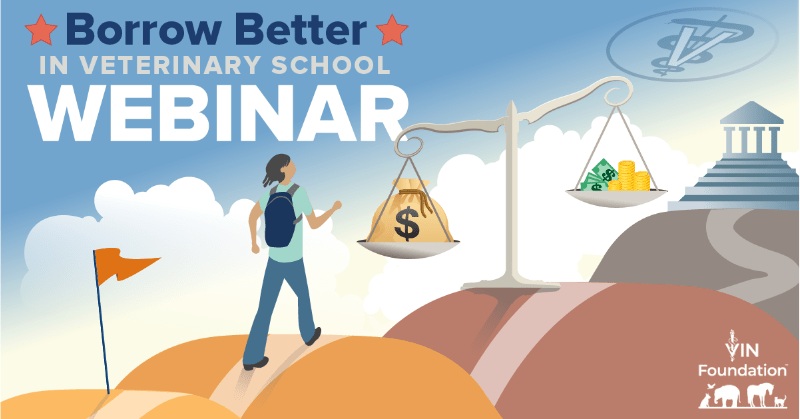Borrow Better

STEPS YOU CAN TAKE NOW AS A VETERINARY STUDENT TO BORROW LESS AND REDUCE YOUR FUTURE STRESS
Most veterinarians (80-90%) borrow to cover their tuition, fees, and living expenses.
Using student loans for your veterinary education is complicated, even more so with recent changes: FAFSA, Direct Loans, Health Professions Student Loans, in-school interest, private loans, family loans, spouse support, savings, job income, etc.
- How do you know which loans, benefits, or resources are best to use now to decrease stress during repayment?
- When do borrowing changes take effect?
- Should I make loan payments during school?
- What will my total balance be at graduation?
- What will repayment look like when you graduate in 2026? 2027? 2028? 2029 and beyond?
- Are student loans the same as other debts?
- How do I best prepare myself for repayment after graduation?
Borrow Better Hint: It is always easier to manage less student debt than more in repayment. Focus on controlling what you can now!
If you’re a veterinarian but do not have access to VIN, then you can join the VIN Foundation Student Debt Message Board area as well to get answers to your student loan repayment questions too!
Recent Borrow Better Resources
If you’re using student loans to pay for veterinary school, you undoubtedly have applied for or received a financial aid award.
This recent presentation will help you assess your award and Borrow Better for the remainder of veterinary school. Learn to create the best plan for you!
2) Borrow Better Prezi
Review the Borrow Better presentation materials including clickable links to the resources referenced in the presentation. Think of this as the “slide deck” that you can click through and review at your own leisure as a quick summary of the webinar.
3) Borrow Better Checklist
All this information can be overwhelming. The Borrow Better Checklist provides a clear outline of five steps to help veterinary students Borrow Better while in veterinary school.
3) A Borrow Better Case Study Using the In-School Loan Estimator
A VIN Foundation Blog post describing a student loan borrowing case study for a Colorado resident starting at CSU’s veterinary school in Fall 2024 using the In-School Loan Estimator.
4) Drip.vet Personal Financial Success Course
BORROW BETTER: NAVIGATING VETERINARY STUDENT LOANS, BORROWING, & REPAYMENT OPTIONS WEBINAR RECORDING
WHAT DOES IT MEAN TO BORROW BETTER?
Avoid the temptation to pay the interest on your student loans while you’re in school. The VIN Foundation Student Debt Education Team often asks students who do this “Where is the money coming from to pay the interest on your student loans?” The most common answer is “my student loans.” You will save more money by reducing what you borrow or returning excess amounts during the 120-day window vs. paying the interest.
- If you have already accepted federal student loans at any point in your educational journey, then retrieve your student aid data file, available when you’re logged into StudentAid.gov. Upload your data file into the VIN Foundation My Student Loans tool by selecting the “I Have Student Loans With More School to Go” option. Once your file is uploaded, you’ll be able to send your current student loan information over to the In-School Loan Estimator and project your remaining costs from there.
- If you have not yet accepted any federal student loans, you can go directly to the In-School Loan Estimator or click the button in the “I Do Not Yet Have Student Loans But I Will” option on the VIN Foundation My Student Loans page.
The helpful three-part student loan series Apply Smarter, Borrow Better and Repay Wiser is part of the VIN Foundation Student Debt Center. The VIN Foundation Student Debt Center is a comprehensive resource helping veterinary students, veterinarians, and those who support them manage student debt through school and beyond. Explore the VIN Foundation Student Debt Center.

